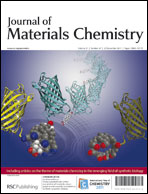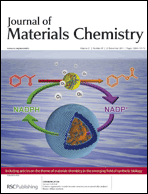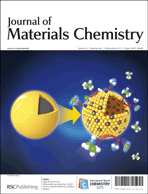This month sees the following Journal of Materials Chemistry articles in that are in the top ten most accessed for October:
Batteries based on fluoride shuttle
M. Anji Reddy and M. Fichtner
J. Mater. Chem., 2011, 21, 17059-17062
DOI: 10.1039/c1jm13535j
Practical aspects of self-organization of nanoparticles: experimental guide and future applications
Nicholas A. Kotov
J. Mater. Chem., 2011, 21, 16673-16674
DOI: 10.1039/c1jm90155a
Are we there yet? Design of better conjugated polymers for polymer solar cells
Hae Jung Son, Feng He, Bridget Carsten and Luping Yu
J. Mater. Chem., 2011, 21, 18934-18945
DOI: 10.1039/c1jm12388b
A review on self-cleaning coatings
V. Anand Ganesh, Hemant Kumar Raut, A. Sreekumaran Nair and Seeram Ramakrishna
J. Mater. Chem., 2011, 21, 16304-16322
DOI: 10.1039/c1jm12523k
Formation of mesoporous TiO2 with large surface areas, interconnectivity and hierarchical pores for dye-sensitized solar cells
Jung Tae Park, Joo Hwan Koh, Jin Ah Seo and Jong Hak Kim
J. Mater. Chem., 2011, 21, 17872-17880
DOI: 10.1039/c1jm10675a
Spinel LiMn2O4/reduced graphene oxide hybrid for high rate lithium ion batteries
Seong-Min Bak, Kyung-Wan Nam, Chang-Wook Lee, Kwang-Heon Kim, Hyun-Chul Jung, Xiao-Qing Yang and Kwang-Bum Kim
J. Mater. Chem., 2011, 21, 17309-17315
DOI: 10.1039/c1jm13741g
Synthesis of monodispersed SnO2@C composite hollow spheres for lithium ion battery anode applications
Y. Chen, Q. Z. Huang, J. Wang, Q. Wang and J. M. Xue
J. Mater. Chem., 2011, 21, 17448-17453
DOI: 10.1039/c1jm13572d
Methods for carbon nanotubes synthesis—review
Jan Prasek, Jana Drbohlavova, Jana Chomoucka, Jaromir Hubalek, Ondrej Jasek, Vojtech Adam and Rene Kizek
J. Mater. Chem., 2011, 21, 15872-15884
DOI: 10.1039/c1jm12254a
Graphene and its derivative-based sensing materials for analytical devices
Shaojun Guo and Shaojun Dong
J. Mater. Chem., 2011, 21, 18503-18516
DOI: 10.1039/c1jm13228h
Light-trapping nano-structures in organic photovoltaic cells
Doo-Hyun Ko, John R. Tumbleston, Abay Gadisa, Mukti Aryal, Yingchi Liu, Rene Lopez and Edward T. Samulski
J. Mater. Chem., 2011, 21, 16293-16303
DOI: 10.1039/c1jm12300a
Why not take a look at the articles today and blog your thoughts and comments below.
Fancy submitting an article to Journal of Materials Chemistry? Then why not submit to us today!



















